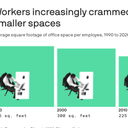The death of the office market was greatly exaggerated

The demise of the office was predicted in the early days of pandemic lockdowns. But the prospect of downtown business districts turning into modern ghost towns is now looking much less likely.
Why it matters: The U.S. office building market is over $2 trillion in size, and vacancies have ticked up, while rents have gone down, over the last year. But many companies are now planning their returns to the office, likely with a hybrid model that allows for more social distancing — a trend that will help offset declining demand for office space.
- “The office sector overall is in the midst of an evolution. Remote work models will likely have a negative impact on office demand,” Katie Vaz, managing director at real estate asset manager Clarion Partners, tells Axios.
Yes, but: While demand for the office space we once knew may be shrinking, one thing that’s likely to offset the trend is a need for a higher average amount of space allocated to each person, Vaz says.
- The technical term is “office de-densification.”
The backstory: Employees have seen their personal in-office space shrink dramatically for decades.
- In 1990, offices offered an average of 325 square feet per employee. That declined to 196 feet by 2020, according to commercial real estate company, JLL.
That course is now expected to reverse.
- For health and safety reasons, employers are adjusting the office set-up for a smaller, hybrid workforce. That provides an opportunity — or even a requirement — for re-imagining technology and space designs to fit new collaboration and communication patterns.
- The momentum toward de-densification actually began before COVID, but has been accelerated by the pandemic, says Will Silverman, managing director at real estate investment bank Eastdil Secured.
Be smart: Most office leases are anywhere from five to 20 years long. The density and design changes will play out over many years as more leases roll off.
- Very few of Clarion's tenants have sought to get out of their leases altogether, Vaz says. Many that have come up for renewal, or are about to, have instead inked short-term extensions to buy time to figure out what will work best.
The big picture: Despite the initial panic, the national office vacancy rate rose somewhat mildly, by less than 1%, between the end of 2019 and the end of 2020, according to Moody’s Analytics.
- In the massive New York City market, effective office rents fell by 2.4% in 2020, much less severe than Moody’s earlier expectation for an 8.6% decline.
- This year, Moody's expects effective rents nationally to fall by 7.5%. That's significant, but not as bad as the 8.9% decline in 2009 at the height of the financial crisis.
Of note: In an August 2020 KPMG survey, 69% of CEOs said they planned on downsizing their office space. In March 2021, just 17% said they’ll be downsizing.
- Tech companies led the remote work revolution at the start of the pandemic, but more recently, companies like Facebook and Amazon have made investments in physical offices.
The bottom line: Many people want to return to the office. But the notion of what the office looks like – and what we do there – is still in flux.